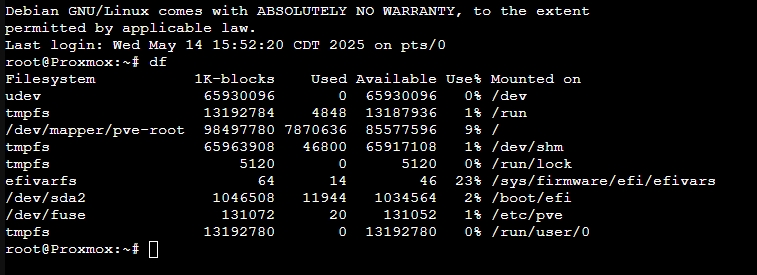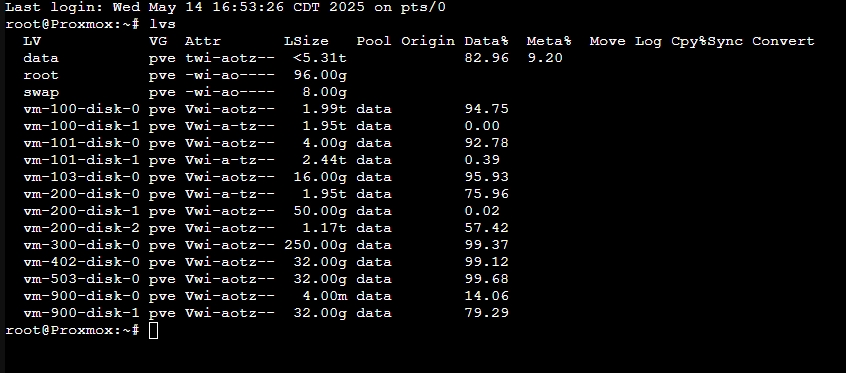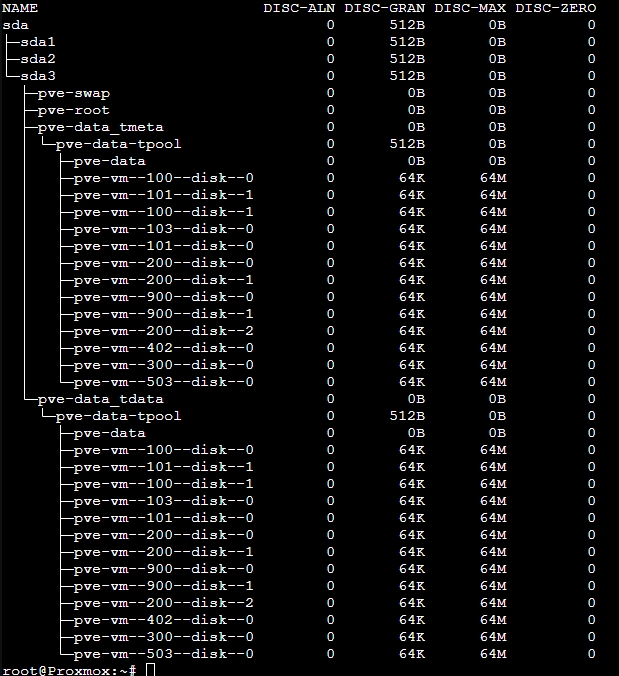Linux
--
Questions
--
Followers
Top Experts
Hi.
I have a Dell R720XD with 6 1TB drives installed. Configured via PERC to raid 5 which leaves me about 5TB usable. I am running proxmox and have 2 containers and 6VMs. Most of the VMs and CTs have very little data. One VM is running Ubuntu Desktop and contains my plex server. That VM has nearly 2TB of data. The data file on my LVM-thin shows that is has used 4.84TB. I cannot for the life of me figure out how this is possible. Searched on the forums, most people fstrim but that's for containers and my containers are not the issue. I bought more drives thinking that adding space to a RAID5 would be easy, turns out it's not so I am hoping someone might have guidance on clearing things up. Discard is enabled on all of the machines. No snapshots. Just a HomeLab guy learning things as I go. I try to not ask questions but every once in a while, i get stuck.
Zero AI Policy
We believe in human intelligence. Our moderation policy strictly prohibits the use of LLM content in our Q&A threads.
Could you have some snapshots taking the extra space?
What does df show us ?
here are a few snapshots. If something more specific would be helpful please let me know.








EARN REWARDS FOR ASKING, ANSWERING, AND MORE.
Earn free swag for participating on the platform.
Does your RAID controller support TRIM
can you post the output of ‘lvs’ please.
From what I can tell the raid controller (PERC H710 Mini) does not support trim. I am not real sure how to definitively determine this.

Get a FREE t-shirt when you ask your first question.
We believe in human intelligence. Our moderation policy strictly prohibits the use of LLM content in our Q&A threads.

google just informed me that the H710 does not support trim. So, without trim, how would one release those unused blocks? I am not sure if it matters or not but I am using SAS drives not SSDs
As it looks to me, you have overbooked the drives for your VMs (which is possible with Thin-LVM; you probably got warnings when doing so), and by calculating the percentages of used space, i come around that amount you described at first. So, it looks to me pretty accurate, that you have used that space. I personally would warn from oversizing volumes, because if they get fuller, it might fill up the thin volume completely, which causes possible damage (for example: if you would fill that vm-100-disk-1 with data, you would exceed that easily)






EARN REWARDS FOR ASKING, ANSWERING, AND MORE.
Earn free swag for participating on the platform.
I respect the input, but i have to disagree. Knowing what data exists and what I am storing its around 2TB. With 6TB on Raid 5 being almost full its preposterous. Yes, it's over allocated with the other VMs, but that is just laziness. Home assistant has a 200 GB allocation, I think. I knew it would not be close to that so i figured why not. Irresponsible yes, but not the culprit, i think.
So, before this machine getting cantankerous and hard to deal with I am considering putting all of my plex data in a cloud somewhere as a backup, then backing up my other VMs and CTs. Burn this whole thing to the ground just start over. If I did so, is there something in initial setup that I should do different to mitigate this issue going forward?
In researching this further it appears that snapshots, and deleted data can fill-up a LVM - does not matter if SDD or HDD
And this needs to be reclaimed , if you do not have supported disks it cannot be reclaimed
It’s a function of LVM
You could run
lsblk --discard
And see what values are returned
The future probably better using ZFS and new JBOD or SCSI HBA controller

Get a FREE t-shirt when you ask your first question.
We believe in human intelligence. Our moderation policy strictly prohibits the use of LLM content in our Q&A threads.







EARN REWARDS FOR ASKING, ANSWERING, AND MORE.
Earn free swag for participating on the platform.
It is odd that Proxmox do state hardware RAID - maybe that’s supports trim/disgards
But many are using ZFS pools using a HBA or cards flashed with IT firmware not RAID
But ZFS is a rabbit hole for configuration with ZIL and Lharc SSDs in front of HDD !
Linux
--
Questions
--
Followers
Top Experts
Linux is a UNIX-like open source operating system with hundreds of distinct distributions, including: Fedora, openSUSE, Ubuntu, Debian, Slackware, Gentoo, CentOS, and Arch Linux. Linux is generally associated with web and database servers, but has become popular in many niche industries and applications.
